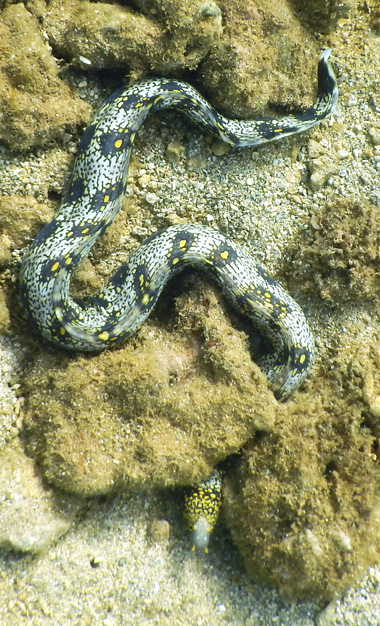Published in the Ocean Watch column, Honolulu Star-Advertiser © Susan Scott
July 29, 2013
Last week I received an email from a reader who went for an early morning swim in Kaneohe Bay. “I looked down and saw what looked like a dozen or so snakes on the floor, maybe 15 feet deep,” the unsigned note said. “Was I seeing things? Sorry, no pics. I just beat it back to the house that I am house-sitting this week.”
With no photo I can’t be sure of the identity of my reader’s “snakes.” but as Hawaii hosts no reef-dwelling sea snakes, my bet is it was a bunch of eels still out from a night of hunting.
 The snowflake moray eel morphs from female to male is it ages.
The snowflake moray eel morphs from female to male is it ages.
©2013 Susan Scott
Because eels are well adapted to hiding in cracks and holes in the reef, and usually search for fish and invertebrates at night, it’s hard to appreciate their numbers and diversity in Hawaii.
Island waters host 42 species of moray eels, second in number only to the wrasses (44). And there are more: snake eels, conger eels, garden eels, worm eels and spaghetti eels. To further muddy the identification waters, some morays are called snake morays, and a few form a family called false moray eels.
But don’t let the shape, names, spots or stripes fool you. All Hawaii’s eels, as well as all eels in the world, are fish. No relation to snakes. It’s just that the serpentine form works well in the ocean.
Because of their snaky appearance, fears and myths about eels abound. But eels are so amazing on their own, we don’t need to make stuff up. Here are some of my favorite eel facts:
- Moray eels usually swallow fish or crabs whole, but when a captured prey is too big, morays tie themselves in knots. The eel forms two loops around its body with its tail and jerks its head through the tightened knot. The motion either tears or flattens the prey into swallowing size.
- The snowflake moray has blunt cone-shaped teeth for crushing its favorite food, crabs and shrimp. This beautiful eel could be the poster child for the transgender community: It begins life female and later changes to male.
- The sharply pointed tails of snake eels are digging tools so efficient that the eels can cruise around tail-first beneath sand and sediment.
- Because some of Hawaii’s eel species bear stripes and spots, people often mistake them for sea snakes. They’re just, however, great pretenders. “Back off,” those colors warn. “I might be a snake.” For my house-sitting emailer, the mimicry worked.
I once witnessed an eel convention while swimming at dusk. After finding myself in the company of eight eels of several species, I too beat it back to my house. My rush, though, was to fetch my camera.
-
 Small Snowflake Eel – Hanauma Bay.
Small Snowflake Eel – Hanauma Bay.
©2013 Scott R. Davis